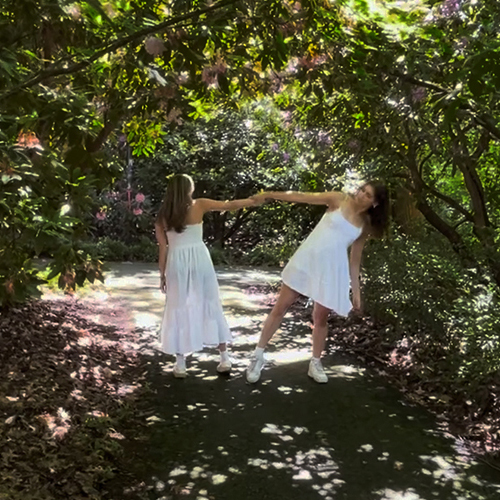Twenty-one years ago, Perspectives newsletter highlighted a new MFA program in dance, intended for retiring professional dancers. The program, the first of its kind, is still going strong two decades later. Here's the original story and an update on the program.
Then: Dancing Through Academia
excerpted from Perspectives, Spring 1991
Graduate studies keep Amy Chavasse on her toes. In between classes on dance, directing, and cinematography, Chavasse teaches ballet to undergraduates and performs in the University’s Chamber Dance Company. It’s all part of an innovative MFA program for retiring professional dancers, introduced by the Dance Program in fall 1990.
The two-year MFA program addresses a common problem in the dance world: life after performance. “Typically, professional dancers have just reached the peak of their careers when they’re lost to the field, due to the physical strain of dancing,” explains Hannah Wiley, director of the Dance Program. “Those who go on to teach usually can’t get a tenure-track position because they’d need a graduate degree. Now they will be able to get that degree.”
Chavasse says that she was attracted to the UW’s program because of its emphasis on performance. All students in the program are required to perform as members of the Chamber Dance Company. “The performing part was a huge sell for me,” says Chavasse. “I didn’t want to give that up to go back to school. This approach suited me perfectly.”
In addition to performing, the graduate students take a full slate of courses each quarter and develop an area of specialization. Chavasse plans to specialize in videography; other students’ specializations include anatomy and kinesiology. All of the students are required to take courses covering the practical aspects of dance, such as dance administration.
Like many other graduate students, the dance students also teach. The teaching is a challenge, Chavasse says, but one she relishes. “It’s very difficult to teach introductory classes, especially if you’ve been a professional for a while,” she says. “You have to stop and rethink how to explain things that are second nature to you.” The payoff: her students’ enthusiasm. “It’s very satisfying to see people get excited by something you love very much,” she says. “It’s very fulfilling.”
Now: Students Transformed
Twenty one years after its introduction, the MFA Program in Dance is still going strong. Alumni of the program have gone on to academic positions at small liberal arts colleges and large universities—including the UW, where alumna Betsy Cooper is chair of the Dance Program and interim dean of the arts in the College of Arts and Sciences.

“The mission statement of the MFA program is to prepare accomplished professional dancers for a career transition into higher education jobs,” says Hannah Wiley, director of the UW’s Chamber Dance Company, Floyd and Delores Jones Endowed Chair in the Arts, and former director of the Dance Program. “That’s what we do. We talk about dance education. We teach them how to write a course proposal. It didn’t take long for people in colleges across the country to realize they wouldn’t have to train dancers to become educators if they hire these folks. Graduates of the program that apply for jobs get them.”
When the program was introduced, it was the first of its kind anywhere. While other MFA programs targeted young students who had not yet had a dance career, Wiley realized that dancers dance with the least injury in their 20s. She felt it made sense for them to “dance first and then be intellectual about it later on.” The UW’s focus on seasoned dancers was unique. Even today, only one other program has a similar approach.
For Wiley, perhaps the biggest surprise of the program has been the integral role of the Chamber Dance Company (CDC) in the students’ education. The mission of CDC, whose dancers are students in the MFA Program in Dance, is to present, record, and archive dances of historical and artistic significance.
“When we started, I thought the Chamber Dance Company was the graduate program’s gift back to the University,” says Wiley. “What I didn’t know was how important performing in the Chamber Dance Company was going to be educationally for the dancers themselves. A lot of the students had been dancing eight to ten years in the same company, dancing the same repertory with the same dancers the entire time. I didn’t fully appreciate how much dancing historic dances would teach them about themselves. It made a lot of them feel more confident teaching dance history, and it expanded their stylistic range.”
The Dance Program has recorded all the CDC performances, dating back to the days of VHS tape. With support from the University’s Royalty Research Fund, Wiley has converted all of the recordings to digital format, creating an archive (viewable in Odegaard Library) that includes more than 90 works from the modern dance canon, with choreography dating back to the 1890s. “It’s probably the largest self-generated modern dance archive in the world,” says Wiley, who has created a series of documentaries combining dance footage with interviews with choreographers and dancers.
Asked to assess the MFA Program two decades after its introduction, Wiley doesn’t hesitate. “I totally believe in it,” she says. “I think my belief in it has deepened. I see the students transform in two years. I watch people who have been beaten up by the professional world build self-esteem and confidence and go out and get job offers. The program’s power has proven itself over and over and over again.”
More Stories

Dancing Across Campus
For the dance course "Activating Space," students danced in public spaces across the University of Washington's Seattle campus this spring.

Read or Listen to Faculty Favorites
Looking for book or podcast recommendations? We asked faculty who've been featured in Perspectives newsletter during the past academic year to suggest a personal favorite.

Meet Our 2024 Graduate Medalists
Meet the three students selected by the College of Arts & Sciences as 2024 Graduate Medalists for their accomplishments.